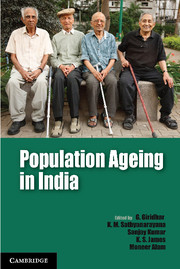Book contents
- Frontmatter
- Contents
- List of Figures
- List of Tables
- Preface
- Acknowledgements
- Introduction
- 1 Demographics of Population Ageing in India
- 2 Elderly Workforce Participation, Wage Differentials and Contribution to Household Income
- 3 Living Arrangements of Elderly in India: Policy and Programmatic Implications
- 4 Health Status of Elderly in India: Trends and Differentials
- 5 The National Policy for Older Persons: Critical Issues in Implementation
- 6 Policy Initiatives on Population Ageing in Select Asian Countries and Their Relevance to the Indian Context
- 7 Studies on Ageing in India: A Review
- Contributors
- Index
6 - Policy Initiatives on Population Ageing in Select Asian Countries and Their Relevance to the Indian Context
Published online by Cambridge University Press: 05 August 2014
- Frontmatter
- Contents
- List of Figures
- List of Tables
- Preface
- Acknowledgements
- Introduction
- 1 Demographics of Population Ageing in India
- 2 Elderly Workforce Participation, Wage Differentials and Contribution to Household Income
- 3 Living Arrangements of Elderly in India: Policy and Programmatic Implications
- 4 Health Status of Elderly in India: Trends and Differentials
- 5 The National Policy for Older Persons: Critical Issues in Implementation
- 6 Policy Initiatives on Population Ageing in Select Asian Countries and Their Relevance to the Indian Context
- 7 Studies on Ageing in India: A Review
- Contributors
- Index
Summary
Background
This chapter draws from a review of the emergence, extent and nature of national policies on population ageing and associated strategies in selected Asian countries in addressing the needs of their senior citizens. The nature and philosophy reflected in the making and implementation of policies and programmes in these countries are in many ways similar, although specific details of care and services vary. They share a complex set of socio-cultural, political, economic, health and development factors which influence policy and programme responses to population ageing. There is an increasing scope and potential for learning from each other as countries are recognizing the growing need for developing such an inter-regional knowledge base for developing their own policy and programme responses to population ageing, including an appropriate conceptual framework that suits the country context.
In Asia, most countries from the mid-twentieth century onwards have experienced a demographic transition resulting in population ageing due to the combined effects of sustained mortality and fertility reduction as well as the emigration of younger people, leading to a significant increase in the proportion (and, more importantly, numbers in large countries) of older persons. There is also a similarity in epidemiological transition characterized by increasing the burden of non-communicable diseases and long-term care (LTC).
- Type
- Chapter
- Information
- Population Ageing in India , pp. 155 - 179Publisher: Cambridge University PressPrint publication year: 2014
- 1
- Cited by

